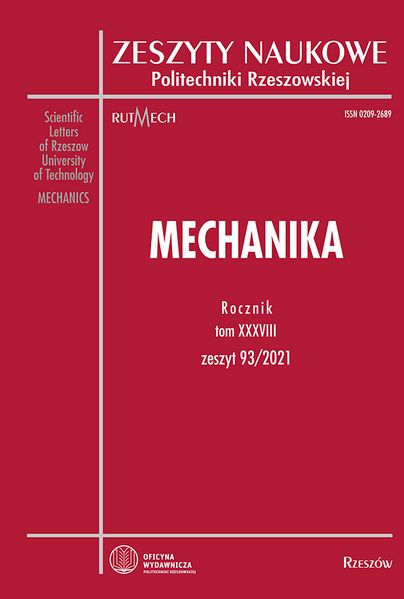Abstract
The article presents the results of tests aimed at determining the influence of sliding burnishing parameters on the surface roughness of rollers made of 42CrMo4 steel. The burnishing process was performed using tools with a polycrystalline diamond tip. Before burnishing, the samples were turned on a tool lathe. The research was carried out according to Hartley's PS / DS-P: Ha3 plan, which enables the definition of a regression equation in the form of a second-order polynomial. Artificial neural network models were also used to predict the roughness of the surface of rollers after burnishing. The considered input parameters of the process included the values of pressure, burnishing speed and feed speed. In all analyzed burnishing cases, the surface roughness value determined by Ra parameter decreased. The differences between the experimental data and the Hartley model did not exceed 24%. The best representation of the Hartley model was obtained for the burnishing parameters: feed f = 0.32 mm / rev, pressure P = 130 N and burnishing speed v = 180 rpm. Multilayer perceptrons were the best predictors of roller surface roughness. With Pearson's correlation coefficient R2 above 0.998, the mean absolute error did not exceed 0.005.
References
Korzynski M., Zarski T.: Slide diamond burnishing influence on of surface stereometric structure of an AZ91 alloy. Surface and Coating Technology 2016; 307: 590–595.
Kumar K., Prasad, K.E.: Application of roller burnishing process for final machining of cylindrical surface. IOSR Journal of Mechanical and Civil Engineering 2016; 12(1): 1–7.
Chomienne V., Valirgue F., Rech J., Vierdu C.: Influence of ball burnishing on residual stress profile of a 15-5PH stainless steel. CIRP Journal of Manufacturing Science and Technology 2016; 13: 90–96.
Zaleski K., Skoczylas A.: Effect of slide burnishing on the surface layer and fatigue life of titanium alloy parts. Advances in Materials Science 2019; 19(4): 35–45.
Labuda W., Starosta R., Charchalis A.: The analysis of the influence of the burnishing process on corrosion properties of steel applied to sea water pump shafts. Journal of Kones Powertrain and Transport 2011; 18(4): 221–228.
Korzynski M., Lubas J., Świrad S., Dudek K.: Surface layer characteristics due to slide diamond burnishing with a cylindrical-ended tool. Journal of Materials Processing Technology 2011; 211(1): 84–94.
Shiou F.J., Cheng C.H.: Ultra-precision surface finish of NAK80 mould tool steel using sequential ball burnishing and ball polishing processes. Journal of Materials Processing Technology 2008; 201(1–3): 554–559.
Maximov J.T., Duncheva G.V., Anchev A.P., Ganev N., Amudjev I.M., Dunchev V.P.: Effect of slide burnishing method on the surface integrity of AISI 316Ti chromium–nickel steel. Journal of the Brazilian Society of Mechanical Sciences and Engineering 2018; 40: 194.
El-Tayeb N.S.M, Low K.O., Brevern P.V.: Influence of roller burnishing contact width and burnishing orientation on surface quality and tribological behaviour of aluminium 6061. Journal of Materials Processing Technology 2007; 186: 272–278.
Cagan S.C., Aci M., Buldum B.B., Aci C.: Artificial neural networks in mechanical surface enhancement technique for the prediction of surface roughness and microhardness of magnesium alloy. Bulletin of the Polish Academy of Sciences Technical Sciences 2019; 67(4): 729–739.
Nalbant M. Gökkaya H., Toktaş I., Sur G.: The experimental investigation of the effects of uncoated, PVD- and CVD-coated cemented carbide inserts and cutting parameters on surface roughness in CNC turning and its prediction using artificial neural networks. Robotics and Computer Integrated Manufacturing 2009; 25(1): 211–223.


